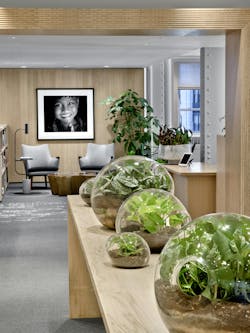A Lesson in Biophilic Design from COOKFOX's Bethany Borel
While sunlight, natural materials, and greenery are great for buildings, biophilic design is more expansive than that. Just ask Bethany Borel, WELL AP, associate partner at COOKFOX Architects in New York.
“Humans have an innate connection to nature. A large volume of research has proven nature’s impact on our physical and psychological state, and we use specific design strategies to invoke or enhance these reactions to improve the user experience within the built environment,” she explains.
Embracing biophilic strategies long before they became an industry buzzword, COOKFOX taps into research from its sister company Terrapin Bright Green, a notable sustainability consulting firm and author of the groundbreaking book Economics of Biophilia, and applies biophilia as an underlying framework for all its projects large and small.
Adding to popular daylighting and natural material selections, Boral shares some other key strategies that may be lesser known:
· Prospect/Refuge – “Having a wide view over an open space from a location of private ‘refuge’ can increase a human’s feeling of safety and comfort, while also reducing cortisol levels so the user can focus,” she explains. Some design strategies include adding banquettes, phone booths, and secluded areas off terraces.
· Connection with natural systems – “As humans, we are part of nature, thus we are closely impacted by the natural cycles of healthy ecosystems.,” says Boral. Consequently, witnessing the landscape transition with the seasons, native plantings, vegetable gardens, and views are sound strategies.
· Non-rhythmic sensory stimuli – “Our current dependence on technology coupled with the time we spend considering data requires us to design workspaces that allow our brains to reset in order to function efficiently. Non-rhythmic sensory stimuli can cause our eye muscles to relax, heart rate to slow, and our sympathetic nervous system to activate.” An example is watching grasses sway in the breeze outside the window.
While multiple strategies comprise a good biophilic design project, Boral cautions against going overboard. “It’s best to focus on achieving a few strategies really well; more is not better. In fact, if too many are used, it can create confusion and end up working against the final design intent.”
WELL Gold Headquarters
To design the healthiest, most efficient space possible, test their design benchmarks, and gain expertise in WELL certification, COOKFOX invested much thought, time, and energy in designing its WELL Gold-certified headquarters at 250 West 57th Street in Manhattan.
As one of the designers heading up the project, Boral shares a few of the biophilic design strategies they applied:
· Optimized daylighting and minimized blue spectrum electrical lighting to support healthy circadian rhythms.
· Framed views of outdoor gardens at each end of the studio.
· Natural materials and textures including white oak doors, carpet with biomimetic patterns. bamboo work surfaces and textured glass mimicking flowing water.
· A garden bed, hydroponic towers, and two beehives on one of the office’s three terraces.
Since joining the team in 2012, Boral’s passion for wellness and sustainability in design has been a great fit with COOKFOX. “There is always more to learn, more to test, more to explore, and most importantly, an opportunity to make a difference,” she concludes.


